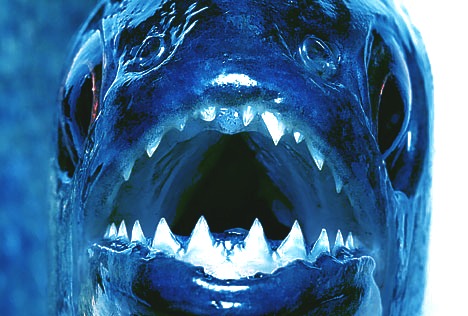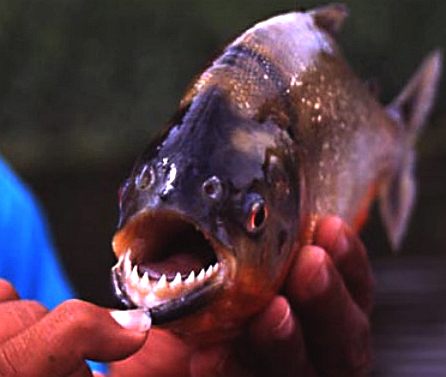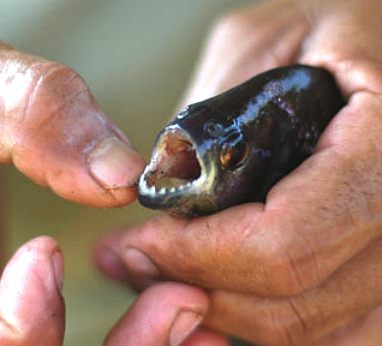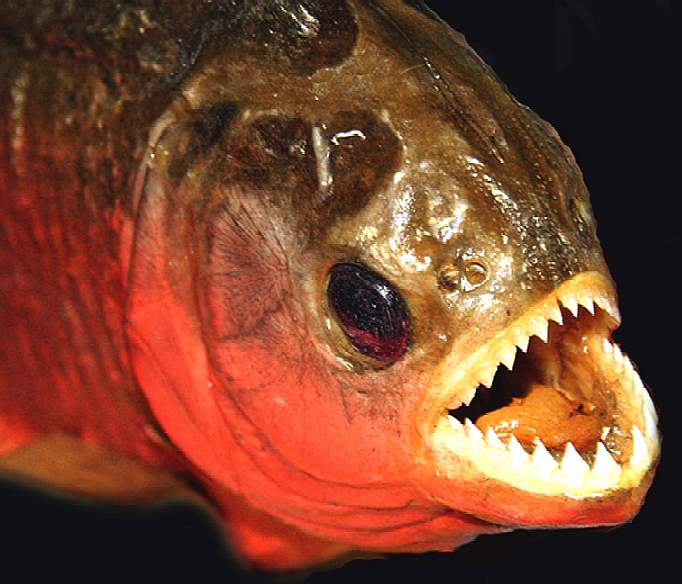|
PIRANHA DOLPHINS | SHARKS | WHALES
|
|||||||||||||||||||||||||||||||||||||||||||||||
|
Piranhas are normally about 14 to 26 cm long (5.5 to 10.25 inches), although some specimens have been reported to be up to 43 cm (17.0 inches) in length.
The piranha or piraña is a member of family Characidae in order Characiformes, an omnivorous freshwater fish that inhabits South American rivers. In Venezuela, they are called caribes. They are known for their sharp teeth and a voracious appetite for meat.
REPUTATION
There are various myths about piranhas such as how they can dilacerate a human body or cattle in seconds. These myths refer specifically to Pygocentrus nattereri, the red-bellied piranha. A recurrent myth is that they can be attracted by blood and are exclusive carnivores. A Brazilian myth called "piranha cattle" states that they sweep the rivers at high speed and attack the first of the cattle entering the water allowing the rest of the group to traverse the river. These myths were dismissed through research by Helder Queiroz and Anne Magurran and published on Biology Letters. Nevertheless, a study in Suriname found that piranhas may occasionally attack humans, particularly when water levels are low.
Attacks resulting in deaths are recurring in the Amazon basin. In 2011 a drunk eighteen-year-old man was attacked and killed in Rosario del Yata, Bolivia. In 2012, a five-year-old Brazilian girl was attacked and killed by a shoal of Pygocentrus nattereri. Some Brazilian rivers have warning signs about lethal piranhas. In 2011, in the Brazilian state of Piauí, there were brutal and recurring attacks resulting in one hundred people being injured. In the State of São Paulo another attack in the Tietê river resulted in 15 injured people. In the city of Palmas, Tocantins, 190 piranha attacks were reported in the first half of 2007. Biologists and experts warn that entering unknown rivers can be dangerous and fatal. Contrary to what many think, piranhas can be found in all regions of Brazil, including rivers, lakes, and coastal areas.
Films have often painted piranhas as aggressive, insatiable predators. An example of this perception in media appears in the 1967
James Bond film You Only Live Twice, where a piece of meat is shown being fed to pet piranhas owned by the film's main antagonist, Blofeld, then only a bone is raised from the water. Later on, a woman is thrown into the piranha pool, although all that is seen is water bubbling vigorously.
ECOLOGY
Piranhas are important ecological components of their native environments. Although largely restricted to lowland drainages, these fish are widespread and inhabit diverse habitats within both lotic and lentic environments. Some piranha species are abundant locally, and multiple species often occur together. As both predators and scavengers, piranhas influence the local distribution and composition of fish assemblages. Certain piranha species consume large quantities of seeds, but unlike the related Colossoma and Piaractus, herbivorous piranhas thoroughly masticate and entirely devour all seeds eaten and consequently do not function as dispersers.
POPULAR FISH:
Please use the Index below to navigate the Animal Kingdom:-
LINKS
http://en.wikipedia.org/wiki/Piranha http://en.wikipedia.org/wiki/Flying_fish http://en.wikipedia.org/wiki/Barracuda https://en.wikipedia.org/wiki/Manta_ray http://en.wikipedia.org/wiki/Bluefish http://en.wikipedia.org/wiki/Tuna
|
|||||||||||||||||||||||||||||||||||||||||||||||
|
This website is Copyright © 1999 & 2013 Max Energy Limited an educational charity working hard for world peace. The bird logos and names Solar Navigator, Blueplanet Ecostar and Utopia Tristar are trademarks. All rights reserved. All other trademarks are hereby acknowledged.
|



